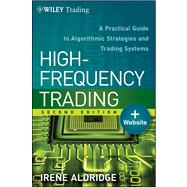
High-Frequency Trading A Practical Guide to Algorithmic Strategies and Trading Systems
by Aldridge, IreneBuy New
Rent Book
Rent Digital
Used Book
We're Sorry
Sold Out
How Marketplace Works:
- This item is offered by an independent seller and not shipped from our warehouse
- Item details like edition and cover design may differ from our description; see seller's comments before ordering.
- Sellers much confirm and ship within two business days; otherwise, the order will be cancelled and refunded.
- Marketplace purchases cannot be returned to eCampus.com. Contact the seller directly for inquiries; if no response within two days, contact customer service.
- Additional shipping costs apply to Marketplace purchases. Review shipping costs at checkout.
Summary
Author Biography
IRENE ALDRIDGE is an investment consultant, portfolio manager, a recognized expert on the subjects of quantitative investing and high-frequency trading, and a seasoned educator. She is currently Industry Professor at New York University, Department of Finance and Risk Engineering, Polytechnic Institute, as well as Managing Partner and Quantitative Portfolio Manager at Able Alpha Trading Ltd., an investment consulting firm and a proprietary trading vehicle specializing in quantitative and high-frequency trading strategies. Aldridge is also a founder of AbleMarkets.com, an online resource making the latest high-frequency research for institutional investors and broker-dealers. Aldridge holds an MBA from INSEAD, an MS in financial engineering from Columbia University, a BE in electric engineering from the Cooper Union in New York, and is in the process of completing her PhD at New York University. She is a frequent speaker at top industry events and a contributor to academic, practitioner, and mainstream media publications, including the Journal of Trading, Futures magazine, Reuters HedgeWorld, Advanced Trading, FX Week, FINalternatives, Dealing With Technology, and Huffington Post.
Table of Contents
Preface
Acknowledgments
Chapter 1: How Modern Markets Differ from Those Past
Media, Modern Markets and HFT
HFT as Evolution of Trading Methodology
What Is High Frequency Trading?
What Do HFTs Do?
How Many HFTs Are There?
Major Players in the HFT Space
Organization of This Book
Summary
End of Chapter Questions
Chapter 2: Technological Innovations, Systems, and HFT
A Brief History of Hardware
Messaging
Software
Summary
End of Chapter Questions
Chapter 3: Market Microstructure, Orders, and Limit Order Books
Types of Markets
Limit Order Books
Aggressive vs. Passive Execution
Complex Orders
Trading Hours
Modern Microstructure: Market Convergence and Divergence
Fragmentation in Equities
Fragmentation in Futures
Fragmentation in Options
Fragmentation in FOREX
Fragmentation in Fixed Income
Fragmentation in Swaps
Summary
End of Chapter Questions
Chapter 4: High-Frequency Data
What is High-Frequency Data?
How Is High-Frequency Data Recorded?
Properties of High-Frequency Data
High-frequency Data Are Voluminous
High-frequency Data Are Subject to the Bid-ask Bounce
High-frequency Data Are Not Normal or Lognormal
High-frequency data are irregularly spaced in time
Most High-frequency Data Do Not Contain Buy and Sell Identifiers
Summary
End of Chapter Questions
Chapter 5: Trading Costs
Overview of Execution Costs
Transparent Execution Costs
Implicit Execution Costs
Background and Definitions
Estimation of Market Impact
Empirical Estimation of Permanent Market Impact
Summary
End of Chapter Questions
Chapter 6: Performance and Capacity of High-Frequency Trading Strategies
Principles of Performance Measurement
Basic Performance Measures
Comparative Ratios
Performance Attribution
Capacity Evaluation
Alpha Decay
Summary
End of Chapter Questions
Chapter 7: The Business of High-Frequency Trading
Key Processes of HFT
Financial Markets Suitable for HFT
Economics of HFT
Market Participants
Summary
End of Chapter Questions
Chapter 8: Statistical Arbitrage Strategies
Practical Applications of Statistical Arbitrage
Summary
End of Chapter Questions
Chapter 9: Directional Trading Around Events
Developing Directional Event-Based Strategies
What Constitutes an Event?
Forecasting Methodologies
Tradable News
Application of Event Arbitrage
Summary
End of Chapter Questions
Chapter 10: Automated Market Making – Naïve Inventory Models
Introduction
Market-making: Key Principles
Simulating a Market-making Strategy
Naïve Market-making strategies
Market-making as a Service
Profitable Market Making
Summary
End of Chapter Questions
Chapter 11: Automated Market Making II
What’s in the Data?
Modeling Information in Order Flow
Summary
End of Chapter Questions
Chapter 12: Additional HFT Strategies, Market Manipulation, and Market Crashes
Latency Arbitrage
Spread Scalping
Rebate Capture
Quote Matching
Layering
Ignition
Pinging/Sniping/Sniffing/Phishing
Quote Stuffing
Spoofing
Pump-and-Dump
Machine Learning
Summary
End-of-Chapter Questions
Chapter 13: Regulation
Key Initiatives of Regulators Worldwide
Summary
End of Chapter Questions
Chapter 14: Risk Management of HFT
Measuring HFT Risk
Summary
End-of-Chapter Questions
Chapter 15: Minimizing Market Impact
Why Execution Algorithms?
Order-Routing Algorithms
Issues with Basic Models
Advanced Models
Practical Implementation of Optimal Execution Strategies
Summary
End of Chapter Questions
Chapter 16: Implementation of HFT Systems
Model Development Life Cycle
System Implementation
Testing Trading Systems
Summary
End Of Chapter Questions
About the Author
About the Website
Index
An electronic version of this book is available through VitalSource.
This book is viewable on PC, Mac, iPhone, iPad, iPod Touch, and most smartphones.
By purchasing, you will be able to view this book online, as well as download it, for the chosen number of days.
Digital License
You are licensing a digital product for a set duration. Durations are set forth in the product description, with "Lifetime" typically meaning five (5) years of online access and permanent download to a supported device. All licenses are non-transferable.
More details can be found here.
A downloadable version of this book is available through the eCampus Reader or compatible Adobe readers.
Applications are available on iOS, Android, PC, Mac, and Windows Mobile platforms.
Please view the compatibility matrix prior to purchase.
